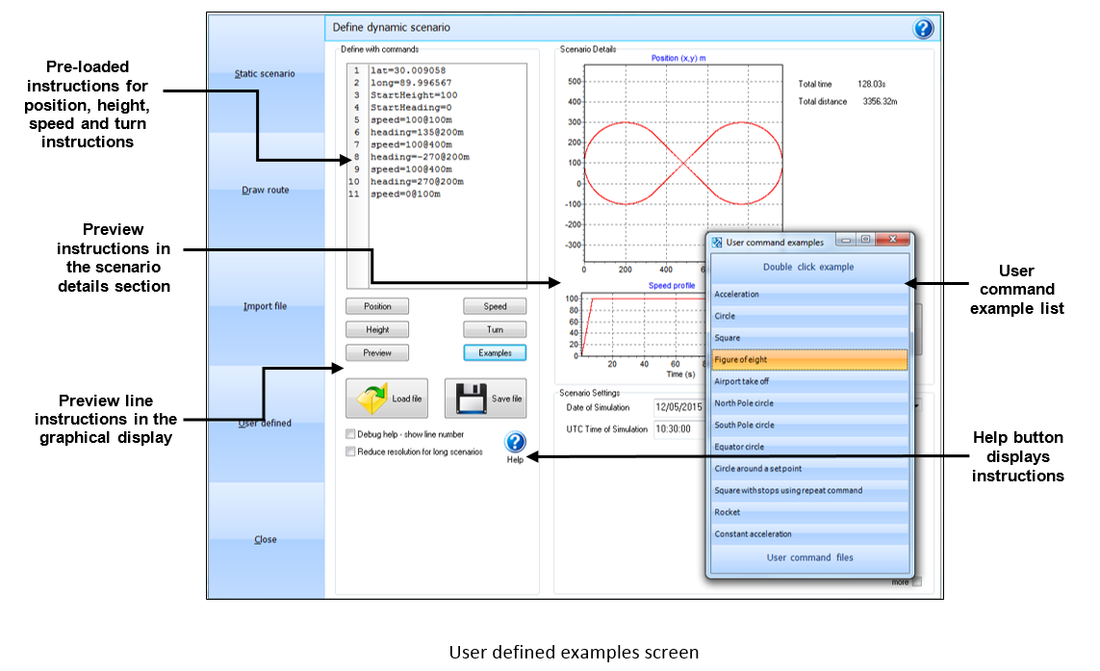07 - SatGen User Defined
The user defined trajectory input feature is the most versatile of all scenario input methods. By building a simple list of commands a trajectory can easily be created. By clicking the Preview Button the Scenario details Section will display the output of the preloaded instructions. By clicking the Help button a full description of the command definitions and update commands types is displayed. A quick and easy way to get going is to load one of the predefined examples loaded in the software by clicking the Examples button. This list of predefined user instructions covers a selection of popular tests to be completed with the SatGen v3 and LabSat combination to test GNSS devices.
Commands available

Recognised user commands details are available in the Help button together with user tips and details of the debug mode:
| Commands to define initial conditions | Commands to update trajectory | ||
|---|---|---|---|
| Lat=+xxxx.xx | {latitude of starting point in degrees} | speed=xxx@yyym | {change velocity to xxx in yyy metres} |
| Long=+xxxx.xx | {longitude of starting point in degrees} | speed=xxx@yyys | {change velocity to xxx in yyy seconds} |
| StartHeight=+xxxx.xx | {height of starting point in metres} | accel=xxx@yyys | {accelerate at xxxm/s2 for yyy seconds} |
| StartHeading=xxx.xx | {initial heading in degrees} | Heading=+xxx@yyym | {change heading by +(or-)xxx degrees, using radius of yyy metres} |
| Wait xxs | {Wait stationary for xx seconds} | Heading=+xxx@yyys | {change heading by +(or-)xxx degrees in yyy seconds} |
| Height=xxx@yyys | {change height to xxx metres in yyy seconds} | ||
| Height=xxx@yyym | {change height to xxx metres in yyy metres} | ||
| vspeed=xxx@yyym | {change vertical speed to xxx in yyy metres} | ||
| vspeed=xxx@yyys | {change vertical speed to xxx in yyy seconds} | ||
| wait xxs | {continue at same speed and heading for xxs} | ||
| repeat=x | {repeat next section x times} | ||
| repeat=end | {end of repeat section} | ||
Should you encounter any memory capacity issues when loading very large files please tick the Reduce resolution for long scenario tick box.
User command examples
A selection of predefined command instructions is available as a set of common user applications. Any of the examples listed can easily be modified to suit user requirements and saved for later use.
| User command example files | Description |
|---|---|
| Acceleration | Example of a simple acceleration and deceleration profile. |
| Circle | Simple circle profile. |
| Square | Simple square profile. |
| Figure of Eight | A figure of eight profile. |
| Airport take off | Take off from a runway. |
| North Pole Circle | Circle around the north pole to test latitude and longitude output. |
| South Pole Circle | Circle around the south pole to test latitude and longitude output. |
| Equator Circle | Circle around the equator to test latitude and longitude output. |
| Circle around a set point | Change the Latitude and longitude settings to move the circle. |
| Square with stops using repeat command | Circuits around a square. |
| Rocket | Basic rocket trajectory. |
| Constant acceleration | Standard acceleration command. |
Advanced Configuration
When you install SatGen, the process will create a ‘SatGen’ folder in the ‘My Documents’ folder on your PC. Inside this ‘SatGen’ folder you will find the UserConfig.txt file. This file gives you access to rarely used features, such as setting the reference clock of LabSat 2 RT to External 10 MHz or selecting which LabSat 2 RT unit to use for real-time simulations if you have several connected to the same computer.
